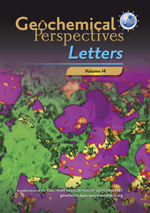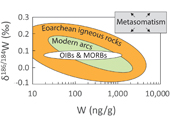 | Stable W isotope evidence for redistribution of homogeneous 182W anomalies in SW Greenland Abstract: We present the first high precision stable tungsten isotope data for a comprehensive Eoarchean rock suite from the Isua region of SW Greenland with the aim to reconstruct the sources and processes that controlled the inventory of W in Eoarchean time and to place constraints on the origin of 182W anomalies in Eoarchean rocks. When compared to modern igneous rocks, the observed range of δ186/184W in the Eoarchean rocks is substantially larger, ranging from −0.072 to +0.249 ‰. But unlike in modern igneous rocks, we find no co-variation of δ186/184W with other geochemical parameters. Multiple stage mobilisation and re-enrichment of W by metasomatic fluids entirely obscured pristine geochemical signals. However, our results illustrate the potential of applying stable W isotopes as geochemical tracer for alteration effects on primary 182W signatures. Despite secondary alteration and the large variation in δ186/184W the excesses in 182W that were previously observed in the same rock samples appear to be unaffected by alteration arguing that the excesses were most likely initially uniform in the whole Eoarchean assemblage of SW Greenland. |
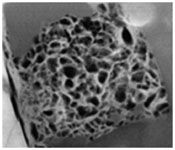 | Tardi-magmatic precipitation of Martian Fe/Mg-rich clay minerals via igneous differentiation Abstract: Mars is seen as a basalt covered world that has been extensively altered through hydrothermal or near surface water-rock interactions. As a result, all the Fe/Mg-rich clay minerals detected from orbit so far have been interpreted as secondary, i.e. as products of aqueous alteration of pre-existing silicates by (sub)surface water. Based on the fine scale petrographic study of the evolved mesostasis of the Nakhla meteorite, we report here the presence of primary Fe/Mg-rich clay minerals that directly precipitated from a water-rich fluid exsolved from the Cl-rich parental melt of nakhlites during igneous differentiation. Such a tardi-magmatic precipitation of clay minerals requires much lower amounts of water compared to production via aqueous alteration. Although primary Fe/Mg-rich clay minerals are minor phases in Nakhla, the contribution of such a process to Martian clay formation may have been quite significant during the Noachian given that Noachian magmas were richer in H2O. In any case, the present discovery justifies a re-evaluation of the exact origin of the clay minerals detected on Mars so far, with potential consequences for our vision of the early magmatic and climatic histories of Mars. |
 | Contributions of visible and invisible pores to reactive transport in dolomite Abstract: Recent technical advances have demonstrated the importance of pore-scale geochemical processes for governing Earth’s evolution. However, the contribution of pores at different scales to overall geochemical reactions remains poorly understood. Here, we integrate multiscale characterisation and reactive transport modelling to study the contribution of pore-scale geochemical processes to the hydrogeochemical evolution of dolomite rock samples during CO2-driven dissolution experiments. Our results demonstrate that approximately half of the total pore volume is invisible at the scale of commonly used imaging techniques. Comparison of pre- and post-experimental analyses demonstrate that porosity-increasing, CO2-driven dissolution processes preferentially occur in pores 600 nm–5 μm in size, but pores <600 nm in size show no change during experimental alteration. This latter observation, combined with the anomalously high rates of trace element release during the experiments, suggests that nanoscale pores are accessible to through-flowing fluids. A three dimensional simulation performed directly on one of the samples shows that steady state pore-scale trace element reaction rates must be ∼10× faster than that of dolomite in order to match measured effluent concentrations, consistent with the large surface area-to-volume ratio and high reactivity of these pores. Together, these results yield a new conceptual model of pore-scale processes, and urge caution when interpreting the trace element concentrations of ancient carbonate rocks. |
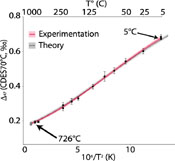 | Clumped isotope temperature calibration for calcite: Bridging theory and experimentation Abstract: Clumped isotopes (Δ47) analysis in carbonates is becoming widespread across the geochemical community as a geothermometer that also allows for the reconstruction of the precipitating fluid δ18O composition. While initial Δ47–temperature relationship discrepancies between laboratories have been considerably reduced over the past 10 years, theoretical temperature calibration and laboratory experimental efforts have still not converged to common ground. Moreover, a lack of high temperature anchor points has weakened its application to high temperature calcite formation. Here we present a temperature calibration for carbonate clumped isotopes between 5 and 726 °C, using synthetically precipitated and heated calcites, to extend the calcite Δ47–temperature calibration to higher temperatures. By showing a strong agreement between the empirical calibration proposed here, theoretical and all recently published T–calibrations made using a full carbonate referencing scheme, this study: (1) provides a calibration allowing more precise application in high temperature geological systems, (2) further supports the improvement of inter-laboratory comparison by using carbonate standards, (3) reconciles empirical temperature calibrations with theory. |
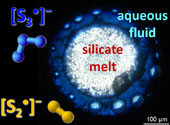 | In situ determination of sulfur speciation and partitioning in aqueous fluid-silicate melt systems Abstract: Current knowledge of sulfur behaviour in magmas is based exclusively on ex situ analyses. Here we report the first in situ measurement of sulfur speciation and partitioning between coexisting aqueous fluids and silicate melts. These data were acquired using Raman spectroscopy in a diamond anvil cell at 700 °C, 0.3–1.5 GPa, and oxygen fugacity in the vicinity of the sulfide-sulfate transition, conditions relevant to subduction zone magmatism. Results show that sulfate and sulfide are dominant in the studied systems, together with the and radical ions that are absent in quenched fluid and silicate glass products. The derived fluid/melt partition coefficients for sulfide and sulfate are consistent with those from available ex situ data for shallow crust conditions (<10 km), but indicate stronger partitioning of these sulfur species into the silicate melt phase with increasing depth. In contrast, both radical ions partition at least 10 times more than sulfate and sulfide into the fluid phase. Thus, by enhancing the transfer of sulfur and associated chalcophile metals from melt into fluid upon magma degassing, and may be important players in the formation of economic metal resources within the redox window of the sulfate-sulfide transition in subduction zone settings. |
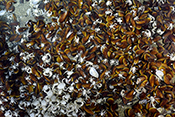 | Lanthanum anomalies as fingerprints of methanotrophy Abstract: Methane is an important greenhouse gas whose emissions into the oceans and atmosphere are regulated by relatively unconstrained anaerobic and aerobic microbial processes. The aerobic pathway for methane oxidation is thought to be largely dependent upon the use of rare earth elements (REE), but to date the effects of this process on their abundances in bacteria or in organisms living in symbiosis with methanotrophs remain to be evaluated. Here we show that deep sea chemosynthetic mussels prospering at methane seeps display distinctive lanthanum enrichments linked to the enzymatic activities of their symbionts. These results demonstrate that methanotrophy is able to fractionate efficiently REE distributions in organisms and possibly in the environment. Lanthanum anomalies recorded in ancient sediments are potential chemical fossils that could be used in the geological record for tracking early evidence of microbial life. |
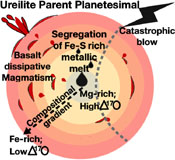 | Ureilite meteorites provide a new model of early planetesimal formation and destruction Abstract: Ureilite meteorites are ultramafic rocks derived from parts of the depleted silicate mantle of their parent planetesimal. We used Monte Carlo modelling to explain the observed array of oxygen isotopes and major element chemistry shown by bulk ureilites, after restoration of their missing core and silicate melt components. Despite using a wide range of primitive nebular material, our modelling shows that only a combination of proxy material resembling Allende-type FeO-rich and MgO-rich chondrules, can account for the ureilite oxygen isotope trend and the reconstructed ureilite major element chemistry. Our model predicts formation of a radial gradient in major elements and oxygen isotopes within the planetesimal, with a more Mg-rich silicate interior and a more Fe-rich silicate exterior. Temperatures recorded by ureilites were not high enough to form a magma ocean but were sufficiently high to form a metallic core and silicate melts. The ureilite parent planetesimal was then disrupted by impact. Re-accretion of the outer layers of more Fe-rich silicate material, at the expense of the more MgO-rich material and the core, explains the observed distribution of bulk rock and mineral compositions. |
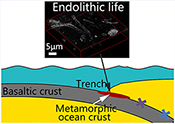 | Past endolithic life in metamorphic ocean crust Abstract: The known deep subsurface biosphere on Earth persists in diversified habitats, including deep within igneous rocks of the oceanic crust. Here, we extend the range of the deep subsurface biosphere to metamorphic ocean crust of a subduction zone. We report fossilised life in zeolite facies rocks, which formed by low grade metamorphism, from the southern Mariana trench. Dense carbonaceous spheroids, filaments, and Frutexites-like structures are preserved in these rocks, which are enriched in organic carbon but depleted in 13C. The distinct difference in the GDGT-0 vs. crenarchaeol and the branched vs. isoprenoid tetraether values between the inner and outer portions of these rocks indicate the in situ production of organic carbon. We demonstrate that these structures may result from the past activity of potential chemolithoautotrophs within the metamorphic crust, as implied by their morphologies, Raman spectra, carbon isotopes, and biomarker signatures, as well as the Fe oxidation state within whole rocks. We propose that fluid-rock reactions at temperatures within the tolerance of life during low grade metamorphism contributed to microbial subsistence within the biotope. The low grade metamorphic ocean crust of the subduction zone likely represents Earth’s deepest, and one of its largest, microbial ecosystems, which may potentially influence the deep carbon cycle. |
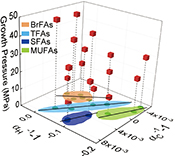 | Carbon and hydrogen isotope fractionation in lipid biosynthesis by Sporosarcina sp. DSK25 Abstract: Pressure dependent fractionation (PDF) of carbon and hydrogen isotopes in lipid biosynthesis by gram-negative piezophilic bacteria has been reported thus far, however, such PDF for gram-positive piezophilic bacteria remains to be characterised. Here, we report for the first time simultaneous quantification of stable carbon and hydrogen isotopic fractionations in lipid biosynthesis by the deep sea gram-positive piezotolerant bacterium Sporosarcina sp. DSK25. DSK25 was grown on glucose at pressures of 0.1, 10, 20, 30, 40 and 50 MPa, and δD and δ13C of bacterial intact polar membrane lipids (IPLs) were determined. Carbon isotope fractionation between IPLs and glucose showed a positive correlation with bacterial growth pressure, whereas hydrogen isotope fractionation between IPLs and growth water exhibited an inverse correlation with growth pressure, suggesting that fractionation of both carbon and hydrogen isotopes is pressure dependent. We further examined the effects of pressure on the isotope enrichment factors of carbon and hydrogen isotopes and propose that the dual isotope derived lambda index, calculated based on bacterial growth pressure, can serve as a diagnostic tool for delineating microbially-driven biogeochemical processes in the deep ocean and deep biosphere. |
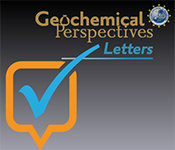 | Corrigendum to “Onset of new, progressive crustal growth in the central Slave craton at 3.55 Ga” by Reimink et al., 2019 |
 | Corrigendum to “Mercury reallocation in thawing subarctic peatlands” by Fahnestock et al., 2019 |
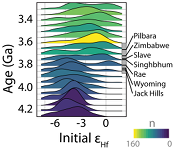 | Hafnium isotopes in zircons document the gradual onset of mobile-lid tectonics Abstract: The tectonic regime of the early Earth has proven enigmatic due to a scarcity of preserved continental crust, yet how early continents were generated is key to deciphering Earth’s evolution. Here we show that a compilation of data from 4.3 to 3.4 Ga igneous and detrital zircons records a secular shift to higher 176Hf/177Hf after ~3.8–3.6 Ga. This globally evident shift indicates that continental crust formation before ~3.8–3.6 Ga largely occurred by internal reworking of long-lived mafic protocrust, whereas later continental crust formation involved extensive input of relatively juvenile magmas, which were produced from rapid remelting of oceanic lithosphere. We propose that this secular shift in the global hafnium isotope record reflects a gradual yet widespread transition from stagnant-lid to mobile-lid tectonics on the early Earth. |
<< Previous issueNext issue >>





